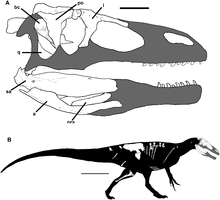
Back Megaraptora Czech Megaraptora Spanish Megaraptora French מגרפטוריים HE Megaraptora Italian メガラプトル類 Japanese Megaraptora Dutch Megaraptora Portuguese Megaraptora Romanian Megaraptora Russian
| Megaraptorans | |||
|---|---|---|---|

| |||
| Diagram showing the skull and skeleton of Murusraptor | |||
| Scientific classification | |||
| Domain: | Eukaryota | ||
| Kingdom: | Animalia | ||
| Phylum: | Chordata | ||
| Clade: | Dinosauria | ||
| Clade: | Saurischia | ||
| Clade: | Theropoda | ||
| Clade: | Avetheropoda | ||
| Clade: | †Megaraptora Benson, Carrano & Brusatte, 2010 | ||
| Type species | |||
| †Megaraptor namunhuaiquii Novas, 1998
| |||
| Subgroups | |||
| |||
Megaraptora is a clade of carnivorous theropod dinosaurs with controversial relationships to other tetanuran theropods. Its derived members, the Megaraptoridae are noted for their large hand claws and powerfully-built forelimbs, which are usually reduced in size in other large theropods.
Megaraptorans are incompletely known, and no complete megaraptoran skeleton has been found. However, they still possessed a number of unique features. Their forelimbs were large and strongly built, and the ulna bone had a unique shape in members of the family Megaraptoridae, a subset of megaraptorans which excludes Fukuiraptor and Phuwiangvenator. The first two fingers were elongated, with massive curved claws, while the third finger was small.[2] Megaraptoran skull material is very incomplete, but a juvenile Megaraptor described in 2014 preserved a portion of the snout, which was long and slender.[3] Leg bones referred to megaraptorans were also quite slender and similar to those of coelurosaurs adapted for running.[2] Although megaraptorans were thick-bodied theropods, their bones were heavily pneumatized, or filled with air pockets. The vertebrae, ribs, and the ilium bone of the hip were pneumatized to an extent which was very rare among theropods, only seen elsewhere in taxa such as Neovenator.[4] Other characteristic features include opisthocoelous neck vertebrae and compsognathid-like teeth.[2]
Megaraptorans were originally placed as basal tetanurans as part of the family Neovenatoridae within the allosauroid clade Carcharodontosauria.[4] By the early 2020s, many studies had come to find that megaraptorans instead represented members of Coelurosauria, with their exact position within this group being uncertain.[5] However, some studies still support an allosauroid classification.[6]
Megaraptorans were most diverse in the early Late Cretaceous period of South America, particularly Patagonia. However, they had a widespread distribution. Phuwiangvenator and Fukuiraptor, the most basal and second most basal known members of the group, lived in Thailand and Japan, respectively. Megaraptoran material is also common in Australia,[7] and the largest known predatory dinosaur from the continent, Australovenator, was a megaraptoran.[8]
- ^ Novas, F., Agnolin, F., Rozadilla, S., Aranciaga-Rolando, A., Brissón-Eli, F., Motta, M., Cerroni, M., Ezcurra, M., Martinelli, A., D'Angelo, J., Álvarez-Herrera, G., Gentil, A., Bogan, S., Chimento, N., García-Marsà, J., Lo Coco, G., Miquel, S., Brito, F., Vera, E., Loinaze, V., Fernandez, M., & Salgado, L. (2019). Paleontological discoveries in the Chorrillo Formation (upper Campanian-lower Maastrichtian, Upper Cretaceous), Santa Cruz Province, Patagonia, Argentina. Revista del Museo Argentino de Ciencias Naturales, 21(2), 217-293.
- ^ a b c Novas, Fernando E.; Agnolin, Federico L.; Ezcurra, Martin D.; Porfiri, Juan; Canale, Juan I. (October 2013). "Evolution of the carnivorous dinosaurs during the Cretaceous: The evidence from Patagonia". Cretaceous Research. 45: 174–215. doi:10.1016/j.cretres.2013.04.001. hdl:11336/102037. ISSN 0195-6671.
- ^ Cite error: The named reference
Porfiri-etalwas invoked but never defined (see the help page). - ^ a b Cite error: The named reference
bensonetal2010was invoked but never defined (see the help page). - ^ Cite error: The named reference
:4was invoked but never defined (see the help page). - ^ Schade, Marco; Rauhut, Oliver; Foth, Christian; Moleman, Olof; Evers, Serjoscha (2023). "A reappraisal of the cranial and mandibular osteology of the spinosaurid Irritator challengeri (Dinosauria: Theropoda)". Palaeontologia Electronica. doi:10.26879/1242. S2CID 258649428.
- ^ Cite error: The named reference
:2was invoked but never defined (see the help page). - ^ Cite error: The named reference
:3was invoked but never defined (see the help page).